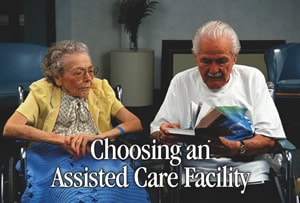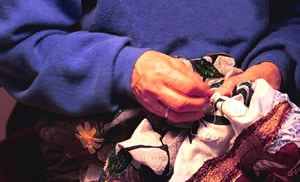Senior Step – Volume 1, 2004 | Download PDF
by Christina DiMartino

ALFA defines assisted living as a housing and healthcare alternative
- Combining independence with personal care
- Offering a warm, dignified community setting
- Having available a special combination of housing, personal supportive services and healthcare designed to meet residents’ daily needs.
Other alternatives listed by AFLA include:
- Independent Living: A residential living setting that may or may not provide hospitality or supportive services. In this setting, the senior adult leads an independent lifestyle that requires minimal or no extra assistance. The government offers such subsidized housing for seniors who qualify. Independent living also includes rental-assisted or market-rate apartments or cottages where residents usually have complete choice in whether to participate in a facility’s services or programs.
- Congregate Housing: Similar to independent living, this type of rental housing usually provides convenience or supportive services like meals, housekeeping and transportation.
- Continuing Care Retirement Communities: Referred to as CCRCs, these communities offer several levels of assistance, including independent living, assisted living and nursing home care. They differ from other types of care facilities in that they usually provide a written agreement or long-term contract between the resident and the community.
- Nursing Home: These facilities provide 24-hour skilled care for the more acute patients. Patients generally rely on assistance for any needed living activities, including bathing, dressing and toileting.
Another option is for the senior to reside in his or her own home, with on-site nursing or attendant care as needed. This can be as little as brief visits a few times a week to 24-hour, 7-day-a-week care. The cost of this option is a problem for many people.
For Extra-Special Needs
People with amputations have legitimate additional concerns about how their special needs will be met. Adequate care facilities are designed with mobility needs in mind. Their staff members are highly trained in how to care for residents with all types of physical restrictions.
Sunrise Senior Living, Inc., is one of the nation’s largest providers of senior living. Sherill Garvey is the senior vice president of Resident Care and Services at Sunrise. She says that encouraging independence is of primary importance, regardless of the mobility restriction.
“This is accomplished through the design of the housing facility, employee training and proactive care,” Garvey says. “It is of equal importance for team members to understand the special needs of those without arms or legs and help these people preserve their dignity.”
The Search for a Home
Garvey says the search for an assisted living community can be a pleasant task. You will, however, need some background information and should not be afraid to ask questions.
Garvey stresses the importance of not waiting until an emergency forces you to find a new home in an assisted care facility.
- Begin your search years before you need it.
- It is best not to feel pressured or rushed into making this important decision in a stressful situation.
- But if you have not handled this part of your care in advance, it should be attended to at the first sign of a potential need.
Garvey suggests:
- Discuss your needs with your doctor.
- Ask your medical professional to suggest facilities where he or she has patients.
- Talk with your friends about their experiences.
- Attend open houses, happy hours and special events at communities that interest you.
- Tour the facility, confer with the administration, and learn the answers to your questions.
- During both scheduled and unannounced visits, ask the tough questions about how the community can meet your particular needs.
- If the answers are satisfactory, ask them if they are willing to put them in writing as a part of your contract.
If you have the time and a desire to give of yourself, volunteer your time in a senior community before you have the need for one of your own. Doing so will provide you with a sense of fulfillment and will bring much pleasure to others. At the same time, it will give you insight into what to expect when it is time for you to move into a facility.

- Use your senses. When touring the community, do you gain a sense of warmth and comfort? What do you see, smell, hear and feel?
- Is the community clean and tidy? Are areas free of debris, providing a sense of organization?
- Are residents engaged in meaningful activities? Do they appear happy and content?
- Do all areas of the facility smell fresh?
- Taste the food. Look over a few menus from previous days. Choices and variety make dining a pleasurable experience.
- Are you permitted to view all areas of the facility, other than those that protect residents’ privacy?
- Are the sounds pleasant and calming? Does music follow you from one area to another?
- Is the facility a place where you could comfortably live? Would you want to have friends and family visit you there?
“The best assisted living providers anticipate physical needs when designing communities,” Garvey says. “The Administration on Aging found that over 70 percent of people age 80 and over have at least one disability.”
Look for these features when evaluating a facility:
- Well-designed common areas and suites that accommodate ease and safety in movement
- Wide doorways, ramps, elevators and carpeting that enable easy mobility
- Bathroom features that include easy-in/out showers, shower seats and handrails
- Easy access to outdoor areas, such as a terraces or courtyards, and freedom of use for residents to enjoy fresh air and sunlight.
The level and range of activities and programs in the facilities you evaluate should welcome residents of all abilities. They should include activities inside the home and outside in the neighborhood. Garvey says to look for the following:
- Transportation to and from events.
- Daily activities and programs that are centered on residents’ interests, not what is convenient for staff.
- A facility where residents look interested and engaged in their activities.
- Activities that celebrate the uniqueness of each resident and offer diverse and educational opportunities for everyone
- Quality and variety in programming that keeps residents active and busy – a key to staying youthful.
“The facility is your home,” Garvey adds. “Friends and family should be welcomed in the community any time you choose.”
A reputable assisted living community will also offer personal care services, such as medication management. It will provide assistance when needed with bathing and dressing, in addition to providing living quarters and meals. However, Garvey says the best facilities go beyond these basic needs.
Before making a final decision on a community, ask yourself one final question: Does the community offer the environment, services and care necessary for me to live a quality life? If the answer is yes, move forward knowing that this new home will be a great place to enjoy your life.


